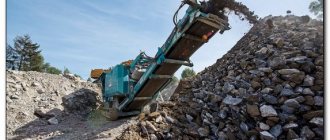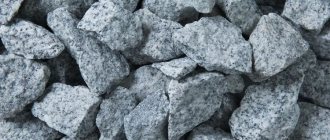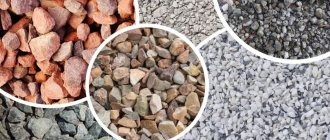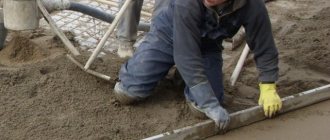Crushed stone is loose material in the form of stones of cuboid, acute-angled, wedge-shaped shape, ranging in size from 5 to 70 mm. The principle of crushed stone production is the same for all types of raw materials:
- Crushing large boulders of rock, gravel, or sintered pieces of waste from the metallurgical industry.
- Separation of bulk mass into fractions with a certain grain size. Thus, the crushed stone fraction 5-20 means that it contains stones with a diameter of 5 to 20 mm.
Pebbles with a diameter above 5 mm are crushed stone, and the fines that have filtered through a sieve with cells of this size are washed and used as sand or screenings. The material is used in almost all areas of construction. But the most applicable and in demand is crushed stone 5-20. This fraction is indispensable in creating high-quality concrete and asphalt concrete mixtures and is used in landscape design and drainage systems.
Types and technical characteristics
The main properties of bulk building material directly depend on the quality characteristics of the feedstock and the results of crushing plants. Crushed stone obtained from the processing of dense rocks must comply with the requirements of GOST 8267-93. When producing crushed stone from low-strength and porous stones, they are guided by the provisions of GOST 22263-76, but if blast furnace slag is used as the raw material, then the main document is GOST 18866-93. Each category of building crushed stone is assigned a name corresponding to the rock or material from which it was made.
Granite crushed stone fraction 5-20
By crushing granite, high quality bulk material is obtained, having:
- uniform cubic grain shape;
- the lowest percentage of flakiness (7-15%);
- good frost resistance - can withstand up to 400 freezing/thawing cycles;
- significant volumetric weight of granite crushed stone – 1600 kg/m3;
- excellent adhesion to all types of binders and mastics;
- low level of water absorption – 0.2% by weight;
- The bulk density of granite crushed stone 5-20 is in the range of 1400-1600 kg/m3.
There is also such a thing as the true density of crushed stone. This value is determined in the dense state of the material, without taking into account voids. In our case, it is equal to 2600 kg/m3.
The listed characteristics plus a high compressive strength - from 800 to 1400 kg/cm2 - made granite crushed stone fr. 5-20 is indispensable in the manufacture of critical concrete and reinforced concrete structures, including those with prestressing reinforcement. In addition, granite crushed stone has found application in the construction of airfield structures, road and railway bridges. It is used by landscape designers to decorate their garden plots in their natural form or painted.
Limestone crushed stone fr. 5-20 mm
In terms of strength indicator (M400-M800), this type of bulk aggregates, along with dolomite crushed stone, is inferior to other types. Almost the same raw materials are used for their production. Main parameters of crushed limestone:
| Strength grade, (M) | from 400 to 800 |
| Frost resistance, (F) | from 50 to 150 |
| Radioactivity, class | 1 |
| Bulk weight, t/m3 | from 1.26 to 1.32 |
Both dolomite and limestone crushed stone are treated with special chemical compounds during the production process. Stones measuring 5-20 mm are used in the construction of non-load-bearing reinforced concrete structures, for the construction of strip foundations for light structures, in metallurgy and glass production. Larger fractions have found use in road construction.
Crushed gravel fr. 5-20
From the very definition of the material it is clear that this type of bulk material is obtained by grinding and sifting coarse gravel. The strength indicators of this material are slightly lower than those of granite crushed stone. Therefore, the remaining characteristics are very similar, for example, the specific gravity of crushed stone of fraction 5-20 from gravel and granite is 2500-2600 kg/m3. It is used for preparing molding mixtures, but for concrete grades not higher than M350.
The main feature of crushed gravel is its decorative effect and pleasant tactile sensations. Therefore, landscape designers love it, including for arranging beach areas.
Many amateur builders, and even sellers of bulk materials, use buckets as a measuring stick. Then the natural question arises, how much does a bucket of gravel or crushed stone weigh? The answer is simple: if the weight of 1 m3 of crushed stone in bulk is 1400 kg, then a 12-liter bucket will hold from 16 to 20 kg.
Marble crushed stone
This material is absolutely environmentally friendly, endowed with a wide range of colors. Due to the property of being easy to machine, for example grinding or polishing, it is used for the device:
- marble and mosaic floor coverings;
- lining of swimming pools, basements of buildings, gazebos, various garden decor items.
In addition, crushed marble is used to make crumbs of different sizes for filling decorative mixtures and coloring compositions.
Crushed slag stone 5-20
This type of filler is made from waste from metallurgical enterprises. It is used as crushed stone for concrete in the production of reinforced concrete products, paving slabs, cinder blocks, thermal insulation materials, and asphalt concrete.
We will see the characteristics of various types of slag crushed stone in comparison with granite in the following table:
| Raw material type | True density, kg/m³ | Average density, kg/m³ | Moisture absorption by mass,% | Compressive strength, MPa | Crushingability indicator, % |
| Granite | 2650 | 2650 | 0,2 | 120 | 11 |
| Slags: | |||||
| dense domain | 2950 | 2820 | 1,5 | 104 | 19 |
| porous | 2940 | 2300 | 7,3 | 62 | 44 |
| open hearth | 3200 | 3030 | 2,3 | 110 | 17 |
| converter | 3100 | 2800 | 4,0 | 76 | 39 |
| copper smelting | 3500 | 3430 | 0,4 | 140 | 6 |
| phosphorus | 2950 | 2850 | 0,9 | 135 | 12 |
The volumetric weight of crushed stone from slag is in the range of 1000-1500 kg/m3.
Application
Due to its outstanding properties and good appearance, crushed granite stone is widely used in construction. After polishing or grinding, its surface acquires a shine, which adds decorativeness to the stone.
But most often crushed granite stone is still used to produce concrete, which with its help acquires the highest strength properties.
All methods of use will depend on what fraction the stone is. Thus, some of its types are used for decorative purposes, sprinkling it on garden paths and playgrounds, while others are used for the construction of road areas, buildings and such complex structures as bridge structures.
It is also used for the production of solutions intended for airfield and asphalt pavements.
What else is useful to know about crushed stone
Any construction requires correct calculation of material consumption. To determine how many cubes are in one ton of crushed stone with a fraction of 5-20 mm, you need to know the bulk density of the material or its volumetric weight. Let's take the average figure - 1350 kg/m3, divide 1000 kg by 1350 and find that a ton of material fits into 0.7407 m3.
If you need the opposite result, that is, to understand how much a cube of crushed stone weighs, then this is the value of the density or mass of the material in bulk.
In addition, when making calculations, it is necessary to take into account such an indicator as the compaction coefficient of crushed stone during compaction and transportation. For preliminary calculations, you need to take standard values from GOST, for example, in the case of using granite crushed stone, the coefficient is 1.1.
Under construction site conditions, special equipment is used to determine this indicator, and the decision is made by construction laboratory specialists based on the results of experimental measurements of the resistivity of the material.
Extraction of granite crushed stone
First, the monolithic rock will need to be blown up to obtain smaller components. To do this, specialists must drill a hole and place a charge in its depth. Usually a series of explosions is carried out, since one is clearly not enough.
If the boulders are too large, they will need to be further blasted. After this, the already crushed particles are sent to a special crushing device. At the last stage, sifting is carried out, which allows the resulting crushed stone to be divided into fractions.
There is also a side method to this extraction method, in which granite crushed stone is obtained by simple sifting.
Description, what kind of material it is, composition, what it looks like
Granite crushed stone is a popular bulk building material in the form of fractions (grains), obtained by crushing large pieces of hardened igneous rock. The main components of the stone are quartz, minerals, mica, and feldspar , which gives granite its various shades. Crushed stone has red, pink, gray colors, depending on the predominance of quartz or spar in the composition.
Granite crushed stone is easy to recognize by its appearance. Photos of Soil Trucks
Density concept
The main parameter that characterizes crushed stone as a building material is its density. It determines what strength characteristics the prepared solution will have, and, accordingly, the future structure or road surface.
The density of crushed stone is determined by the ratio of its mass to the volume it occupies.
Most often, measurements of this physical quantity are made in kilograms per cubic meter (kg/m3) or in tons per cubic meter (t/m3).
This is due to the fact that usually quite a lot of crushed stone is required, so smaller units of measurement will not be optimal. More accurate density measurements can be obtained by measuring it in two different ways.
The first is a bulk indicator, which shows the density of the stones along with the air gaps that form in them. The second is the true density, which differs without taking into account free space, for which a special measuring container is used.
Density
It is necessary to understand the differences between different quantities in order to correctly operate with them when calculating the amount of material.
The true density is determined in the laboratory by completely crushing the crushed stone to a state in which there is a minimum amount of space between its particles.
This is required for high-precision engineering calculations, although in ordinary construction such measurements are not very useful. Bulk density is of much greater use, since it is in this state that crushed stone is used for preparing cement-sand mixtures.
Currently, quarry sand is the most common and sought-after material in construction. Here are the characteristics of this material.
Today it is impossible to imagine any construction or renovation without the use of cement. Here are the features of cement grade M400.
Tile adhesive is an important component of any repair and therefore it is worth thinking in advance about how much of it you need to purchase. By following the link you can see its consumption.
Various methods are used to measure bulk density, but they all represent approximately the same mechanism of implementation. The material is first poured into a special container, after which its weight is measured.
How is it different from limestone?
Limestone and granite crushed stone is mined by crushing sedimentary and rock formations. The bulk density and flakiness of the materials are approximately the same. Limestone crushed stone is cheaper (by about 30%), but the number of areas for its application is smaller. Limestone is inferior to granite in strength (the maximum value is 2 times less) and frost resistance (also 2 times less). The only advantages over granite are higher environmental friendliness and lower weight. The average radioactivity of crushed limestone is almost 6 times less.
Limestone crushed stone 20-40. Photos of Soil Trucks











